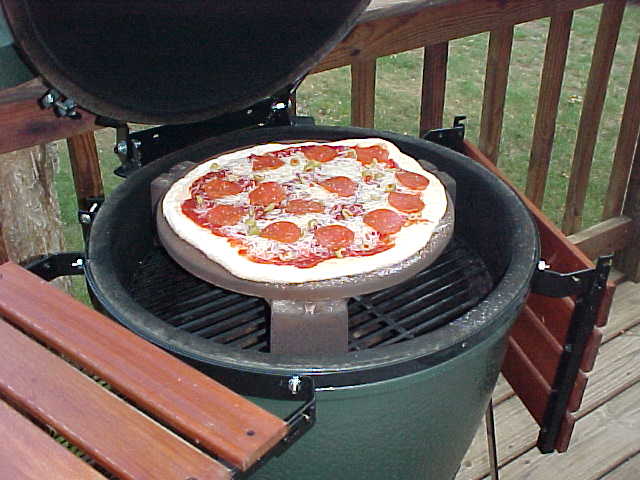Welcome to the EGGhead Forum - a great place to visit and packed with tips and EGGspert advice! You can also join the conversation and get more information and amazing kamado recipes by following Big Green Egg to Experience our World of Flavor™ at:
Want to see how the EGG is made? Click to Watch
Facebook | Twitter | Instagram | Pinterest | Youtube | Vimeo
Share your photos by tagging us and using the hashtag #BigGreenEgg.
Share your photos by tagging us and using the hashtag #BigGreenEgg.
Want to see how the EGG is made? Click to Watch
Pizza Info Required
Options
I have a place setter (the one with the legs) that I assume can be used for pizza. I am told that I will require a pizza stone to place on top of the setter (???) I was also told that the pizza stone could be ceramic available at most any 'cheaper' supply store. Questions: do I need a stone to place on top of the setter? Do I elevate the setter on top of the existing grate or remove the grate and place the setter in its place? How about cooking time or in the case of a frozen pizza (???) As you can see I'm rather in the dark re this project and would greatly appreciate some help. Thanks in advance. Bully
Comments
-
Bully,
You put the plate setter on top of the ring. You don't need a grid underneath it. Yes, you really need a pizza stone on top of the plate setter. The PS is too small for my liking. I bought a 16" pizza stone from Crate and Barrel that fits/works perfectly in the large egg. As for temperature, there are two approaches. The first is to preheat the stone only enough to get it to the temperature that works for the type of pizza you are cooking. I don't do this, so I can't help on times or temps. I like to heat the stone until it reaches equilibrium with the heat of the egg. That way, the heat of the stone isn't going to change. If you are doing a DiGiorno or Freschetta, use the times and temps on the package. Spin also recommends that you put it on a grate on top of the stone. People who cook pizza's with homemade dough a'la Spin's recipe usually cook the pies at 650 or so. I cook the pies I get from my local pizzaria at 500-550.[p]A tip that someone passed along from a pizzaria was that if you find that the stone is too hot and the crust is burning but the toppings aren't getting done, before you put the pie on the stone, wipe it with a damp rag to cool the stone a bit. Then, as long as you keep pies on the stone, it should remain at a cooler temp. [p]Good luck. The bottom line with pizzas is to experiment until you get the time/temp/technique that works for you.[p]TNW
The Naked Whiz -
Bully,
Doing good pizza takes a little practice; but you get to eat the experiments!
I've never done frozen, so take TNW's advice.
Yes, you will need a pizza stone to go on top of the plate setter. I unfortunately bought a small one so I had to buy a larger one. Once my fire is started, I put the plate setter on top the grid, then the stones and bring the egg up to 600 degrees or so. The advantage to leaving the grid in...easy way to clean it. I let the plate setter/pizza stone heat up for 20-30 minutes. Slide the pie on and in 10-12 minutes, it's done. If you want to check on it, look thru the top vent.
Any other questions, ask away or email.
-
<p />Bully,[p]I have read a few dozen posts by folks who bought a thin stone designed for an oven. Pappered Chief is one I recall seeing many posts about it cracking the first time it hits 400°. I suggest you get a good stone. Several ceramic cooker companies have good ones that will last. I have had 2 for about 4 years and they work well with a setter for pizza.[p]Tim

Categories
- All Categories
- 182.7K EggHead Forum
- 15.7K Forum List
- 459 EGGtoberfest
- 1.9K Forum Feedback
- 10.3K Off Topic
- 2.2K EGG Table Forum
- 1 Rules & Disclaimer
- 9K Cookbook
- 12 Valentines Day
- 91 Holiday Recipes
- 223 Appetizers
- 516 Baking
- 2.4K Beef
- 88 Desserts
- 163 Lamb
- 2.4K Pork
- 1.5K Poultry
- 30 Salads and Dressings
- 320 Sauces, Rubs, Marinades
- 543 Seafood
- 175 Sides
- 121 Soups, Stews, Chilis
- 35 Vegetarian
- 100 Vegetables
- 313 Health
- 293 Weight Loss Forum